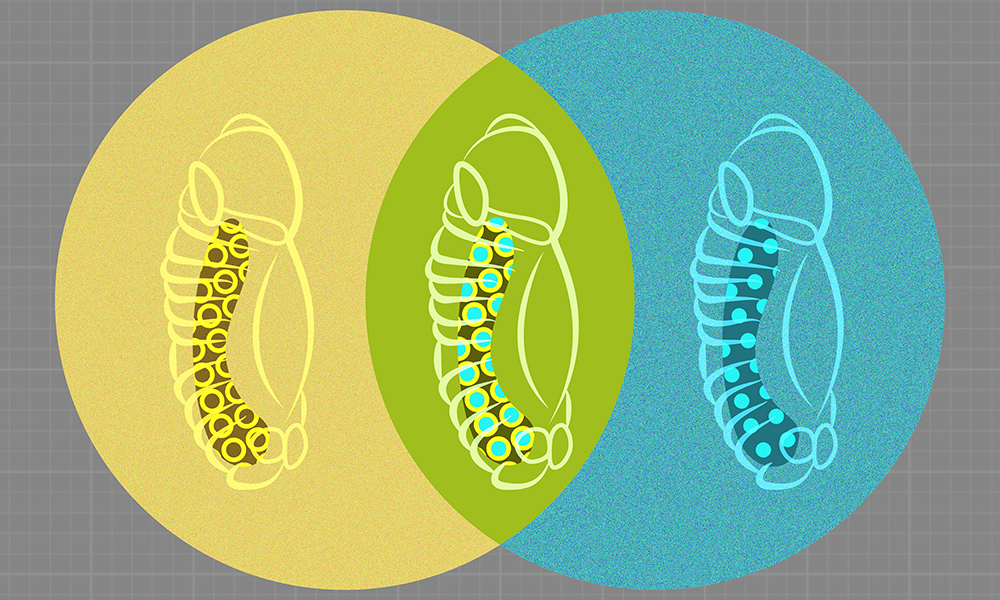Simultaneous cellular and molecular phenotyping of embryonic mutants using single cell regulatory trajectories
Developmental Cell 16 February 2022
10.1016/j.devcel.2022.01.016
EMBL researchers develop a new approach to characterise developmental mutants with unprecedented resolution, simultaneously uncovering both molecular and cellular phenotypes

Imagine trying to build a house starting with a single brick. The brick contains not only instructions for making more bricks, but the blueprint of the house itself, with plans for everything from plumbing to pest management. This brick can even act as the foreman and the director of the work.
It may sound far-fetched, but this is basically how the process of embryonic development functions. Going from a single cell to a full-fledged organism requires a tremendous amount of regulation at the genomic level, the complexities of which are difficult to appreciate through traditional approaches. Researchers from EMBL’s Furlong group have now come up with a way to observe this process through multiple overlapping lenses, generating a full-colour view of how different cell lineages form in the developing embryo and are impacted by genomic mutations.
During development, stem cells progressively specialise to become specific cell types, tissue and organs that have very precise and complex functions in the organism’s body. This process is driven to a large extent by the coordinated turning on and off of several genes. Some of the most important players in this process are transcription factors – proteins which bind to regions of DNA called ‘enhancers’ and alter the expression of other genes.
“Our lab’s longstanding goal is to understand how enhancers operate in regulatory networks,” said Stefano Secchia, the first author of the study published in Developmental Cell. “However, most studies on transcription factors and enhancers either focus on molecular readouts, ignoring the underlying cellular phenotypes, or on cell- or tissue-level changes, with poor integration of the underlying molecular phenotypes.” To overcome this challenge, the team developed an innovative approach.
The researchers first collected fruit-fly embryos at many overlapping stages of embryonic development and isolated their nuclei. They then subjected these nuclei to a technique known as single-cell ATAC sequencing, which identified which regions of DNA were accessible at each stage of development. This in turn indicated which enhancers and transcription factors were active. On top of that, the single-cell resolution of the data also allowed them to map the developmental trajectory of various cell populations across time, focusing particularly on cells that give rise to key muscle groups.
The researchers then compared this data with parallel experiments done in mutant embryos where certain critical transcription factors were inactive. This allowed them to uncover the precise role these transcription factors play in the development of certain cell lineages simultaneously at the genetic and cellular levels – something no previous method had been able to do so far.
“With traditional approaches like microscopy, it is often only possible to characterise the cellular state of tissues when appropriate markers and antibodies are available,” said Secchia. “And typically, people only look at the tissue that they are interested in, which means that many phenotypes go unnoticed. On the other hand, while molecular changes can be detected by traditional genomic methods, there is often ambiguity about when and where the changes are taking place. With the approach we developed in this study, it is now possible to capture all of this information in the same experiment, with a more quantitative, integrated, and unambiguous view.”
This new framework not only provides a high-resolution view of embryonic development, it also allows researchers to observe subtle changes that occur when particular transcriptional regulators are lost. For example, embryos of one of the mutant fly strains had mutant cells that formed a new, abnormal cellular state compared to wild-type cells, which would be nearly impossible to determine by regular immuno-staining techniques.
“Integration of this approach with future lab studies will ultimately lead us to a better understanding of developmental regulatory networks, in addition to providing new insights into the plasticity of cell states during embryogenesis,” said Eileen Furlong, group leader and corresponding author of the paper.
Eileen Furlong recently received the Leibniz Prize 2022 for her work on fundamental mechanisms of genome regulation, including the function of developmental enhancers. She plans to use the awarded funds to further explore mechanisms of how regulatory elements function in the three-dimensional nucleus and how they regulate robust developmental programmes. The new study represents one more stride forward for the group towards systematically dissecting the role of enhancers in development, by integrating cellular and genetic approaches.
“In my opinion, this is a new, more unbiased, systematic way to phenotype mutants,” Furlong said. “We can now go back and phenotype classic mutants with this enhanced resolution, in addition to completely new uncharacterised mutants. I hope this will inspire many researchers to phenotype their mutants in the same way.”
Developmental Cell 16 February 2022
10.1016/j.devcel.2022.01.016
Looking for past print editions of EMBLetc.? Browse our archive, going back 20 years.
EMBLetc. archive